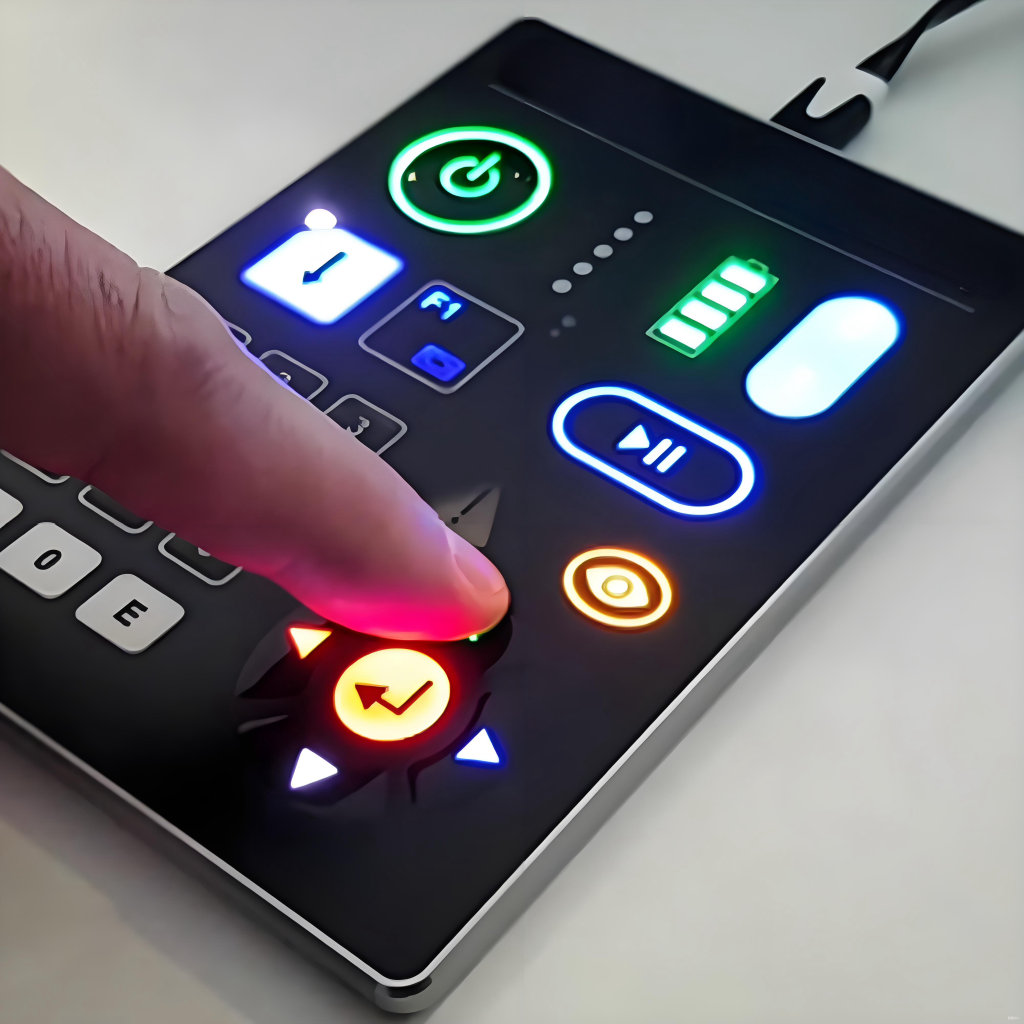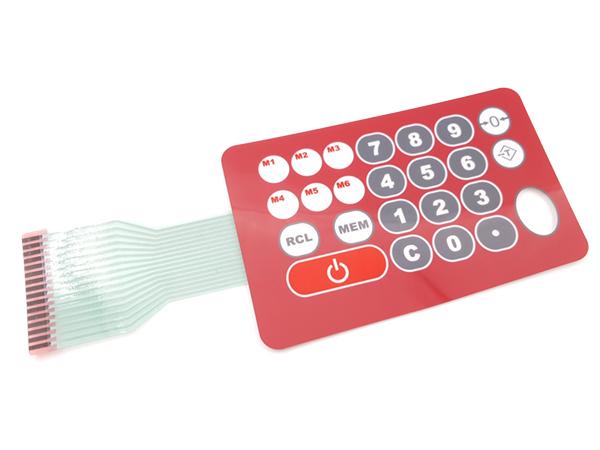
What is LED backlight membrane switch? LED membrane switch
What is LED backlight membrane switch? LED membrane switch
What Is an LED Backlight Membrane Switch?
An LED backlight membrane switch is a flat, flexible interface that integrates LEDs beneath the tactile buttons. This setup illuminates the switch surface, making controls visible even in low-light environments.

The switch consists of several layers:
- Graphic overlay: The top layer displays icons, text, or symbols for user guidance.
- Spacer layer: Keeps the conductive layers separate to prevent accidental activation.
- Circuit layer: Transmits the electrical signal when the button is pressed.
- LED layer: Provides backlighting to improve visibility and feedback.
- Adhesive backing: Secures the switch to panels or devices while maintaining slimness.
LED backlighting can be monochrome, multi-color, or programmable. Some designs allow brightness adjustment to respond to ambient lighting, enhancing usability.
In essence, these switches combine tactile feedback and visual cues, improving the user experience while maintaining durability and a compact design.
How Does a Membrane Switch with LED Backlight Work?
The operation of a membrane switch with LED backlight is simple yet clever. When a user presses a button:
- The graphic overlay flexes slightly under pressure.
- The conductive circuit layer beneath touches the contact layer.
- This closes the electrical circuit, sending a signal to the device.
- Simultaneously, the LED layer illuminates the button.
LEDs are usually mounted in a matrix or embedded in light guides. Light guides spread the light evenly, avoiding bright spots.
The LEDs can serve multiple purposes:
- Highlight active buttons.
- Indicate device status with color cues.
- Provide error alerts through distinct illumination.
This combination of tactile and visual feedback makes LED membrane switches highly intuitive. Users can operate them accurately, even in dark or noisy environments.
Where Are Backlit Membrane Switches Commonly Used?
Backlit membrane switches appear in a wide range of industries, thanks to their versatility and visual appeal. Some of the most common applications include:
- Medical devices: Surgical tools, patient monitoring systems, and diagnostic instruments benefit from illuminated switches that are easy to identify.
- Industrial control panels: Factories, robotics, and automation systems rely on clear feedback from backlit buttons.
- Consumer electronics: Remote controls, calculators, and home appliances often feature LED membrane switches for stylish, functional design.
- Transportation: Automotive dashboards, airplane cockpits, and marine control panels use backlit switches to enhance visibility in low-light conditions.
- Security and access systems: Keypads and security panels employ illuminated membrane switches for easy identification in dimly lit areas.

These applications demonstrate the versatility of backlit membrane switches. They offer clarity, reliability, and a professional appearance, making them ideal for both user experience and design aesthetics.
How to Choose the Right LED Switchback Module?
Selecting the right LED switchback module requires understanding your application, environment, and user needs. Here are some key considerations:
- Brightness and color: Determine the LED brightness and color requirements based on the ambient lighting and user expectations. Multi-color options can provide status feedback.
- Flexibility and size: Consider the space available on your device. Membrane switches are slim, but the LED layer must fit without compromising design.
- Durability: Choose LEDs rated for continuous use in your environment. Some modules are more resistant to vibration, heat, or moisture.
- Power efficiency: Ensure the LEDs operate efficiently without excessive power consumption, especially for battery-powered devices.
- Integration with control system: Make sure the module can easily connect to the device’s circuitry and microcontroller for smooth operation.
Can LED Membrane Switch Panels Improve Visibility?
Absolutely. LED membrane switch panels are specifically designed to enhance visibility in any condition. The illumination ensures users can clearly identify buttons, symbols, and instructions.
Even in complete darkness, a backlit membrane switch provides visual guidance, reducing mistakes and improving efficiency. For devices used in emergencies, such as medical equipment or control panels, this feature can be critical.
Additionally, LED backlighting can be customized to guide user attention. For example, buttons that require immediate action can be brighter or use a different color. This improves response time and makes operation more intuitive.
Overall, LED membrane switch panels significantly enhance usability, especially in low-light or fast-paced environments.
What Are the Benefits of a Backlit Membrane Switch Design?
The benefits of backlit membrane switches extend far beyond aesthetics:
- Enhanced usability: Users can easily identify buttons, reducing errors.
- Sleek design: Thin and flexible overlays allow modern, minimalist designs.
- Customizable illumination: LEDs can be color-coded, dimmed, or made programmable.
- Tactile feedback: Users get a satisfying press without mechanical noise.
- Low maintenance: Sealed layers prevent dust, moisture, and contamination from affecting performance.
- Energy efficiency: LEDs consume minimal power while delivering maximum visibility.

This combination of tactile, visual, and ergonomic benefits makes backlit membrane switches a preferred choice for demanding applications.
How Durable Is an LED Membrane in Harsh Environments?
LED membrane switches are remarkably robust. They are designed to withstand challenging conditions without losing functionality. Features contributing to durability include:
- Sealed construction: Protects against dust, liquids, and chemical exposure.
- High-quality materials: Polyester and polycarbonate overlays resist scratches, wear, and heat.
- LED longevity: Modern LEDs can withstand continuous use without dimming or failure.
- Vibration resistance: Ideal for vehicles, machinery, and industrial equipment.
Even in extreme environments, LED membrane switches maintain consistent performance, ensuring reliability where it matters most.
What’s the Lifespan of a Backlit Membrane Switch?
The lifespan of a backlit membrane switch depends on usage, design, and environment. Typically, these switches can last millions of actuations, far exceeding traditional mechanical buttons.
LEDs themselves are long-lasting, often rated for 50,000–100,000 hours of illumination. With proper design and quality materials, the switch can remain fully functional for years, even in heavy-duty applications.

This durability, combined with low maintenance and high reliability, makes LED membrane switches a smart investment for both consumer and industrial products.
Conclusion:
LED backlight membrane switches combine an attractive design, durable quality, and intuitive operation in a slim package. From medical devices to industrial control panels, these switches enhance the user experience and deliver professional-grade performance.
The longevity and reliability of LED membrane switches make them a cost-effective and highly efficient choice for any modern device.
For customized LED backlight membrane switches, high-quality solutions, and expert advice, contact our sales team at sales@best-membraneswitch.com

Know the Difference between Tactile and Non-Tactile Membrane Switching
When selecting the appropriate interface for a product, it can be wise to understand the differences between tactile and non-tactile membrane switches so that the engineer and the purchaser make a better decision. They are both very common in medical equipment, domestic appliances, and industrial equipment, though they do not present the same user experience. ...

Step-by-Step Guide to Selecting the Right Membrane Switch for Your Product
It is not easy to choose the appropriate interface for an electronic device with the number of various types of membrane switches. This is a basic, stepwise analysis to help product designers and manufacturers select the optimal choice. Step 1: Determine your Application Requirements Begin by making a list of locations where switches are used, ...

Top Membrane Switches for Home Electronics Projects in 2025
You can elevate your home electronic membrane switch project in 2025 with standout models such as the 4×4 Matrix 12 Keys Keypad from SOUSHINE, the rgb-enabled strip switches from Molex, and custom graphic switches by Panasonic. These switches offer slim profiles and reliable performance, making them easy to integrate into your DIY setup. You gain ...
Contact us online